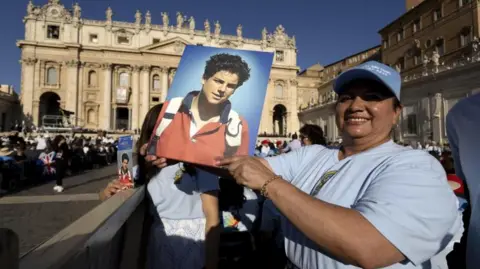In a solemn atmosphere at the Vatican, the conclave of cardinals is actively engaged in the critical process of selecting a successor to Pope Francis. The cardinals, who form the Roman Catholic Church's hierarchy just below the pope, will cast their votes via secret ballot until one candidate achieves the required two-thirds majority. While the proceedings remain hidden from the public eye, the methods employed during this sacred assembly are deeply rooted in tradition, incorporating a specific set of objects and procedures.
As the voting unfolds in the revered Sistine Chapel, the cardinals will sit at simple wooden tables arranged in rows. Central to the room's activities is a sizable table designated for the officials overseeing the election process, as prescribed by the Universi Dominici Gregis (U.D.G.), the governing document outlining the papal transition. The voting instruments include an urn designed for collecting the ballots, rectangular voting papers inscribed with "Eligo in Summum Pontificem" (Latin for "I elect as Supreme Pontiff"), and a unique assembly of wooden balls.
Each ballot provides space for the cardinals to record their chosen candidate's name, with the completed ballots being deposited into the urn following the conclusion of voting. To ensure authenticity and accuracy, wooden balls marked with numbers corresponding to the cardinal count are employed during the ballot-counting phase. An attendant removes one ball for each ballot, ensuring that both figures correlate. Should there be any discrepancy, the ballots are immediately incinerated without examination, prompting a fresh round of voting as detailed in the U.D.G.
As the conclave progresses, the outcome remains uncertain, but the commitment to tradition is palpable in every symbolic item used and in the careful adherence to these established practices. Each vote holds profound significance in determining the future of the Catholic Church.
As the voting unfolds in the revered Sistine Chapel, the cardinals will sit at simple wooden tables arranged in rows. Central to the room's activities is a sizable table designated for the officials overseeing the election process, as prescribed by the Universi Dominici Gregis (U.D.G.), the governing document outlining the papal transition. The voting instruments include an urn designed for collecting the ballots, rectangular voting papers inscribed with "Eligo in Summum Pontificem" (Latin for "I elect as Supreme Pontiff"), and a unique assembly of wooden balls.
Each ballot provides space for the cardinals to record their chosen candidate's name, with the completed ballots being deposited into the urn following the conclusion of voting. To ensure authenticity and accuracy, wooden balls marked with numbers corresponding to the cardinal count are employed during the ballot-counting phase. An attendant removes one ball for each ballot, ensuring that both figures correlate. Should there be any discrepancy, the ballots are immediately incinerated without examination, prompting a fresh round of voting as detailed in the U.D.G.
As the conclave progresses, the outcome remains uncertain, but the commitment to tradition is palpable in every symbolic item used and in the careful adherence to these established practices. Each vote holds profound significance in determining the future of the Catholic Church.




















